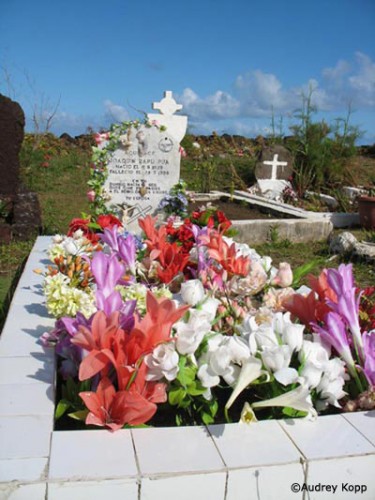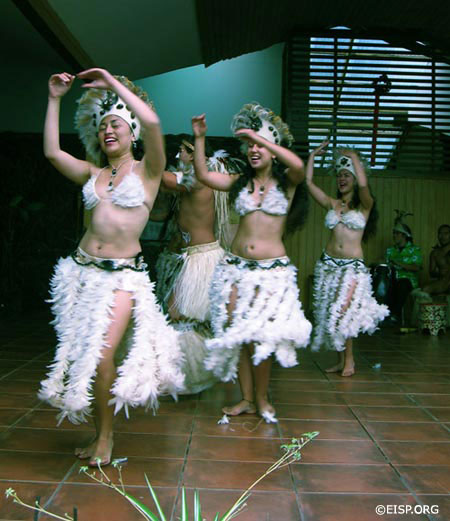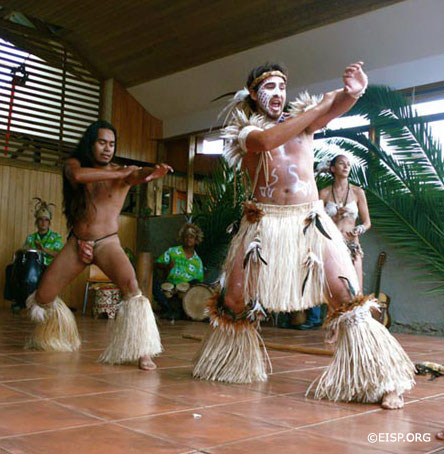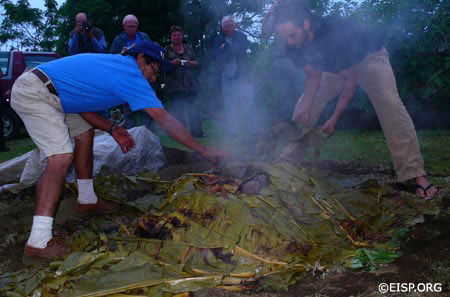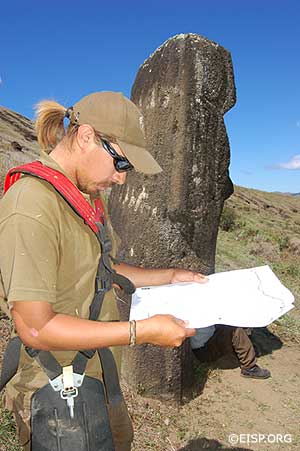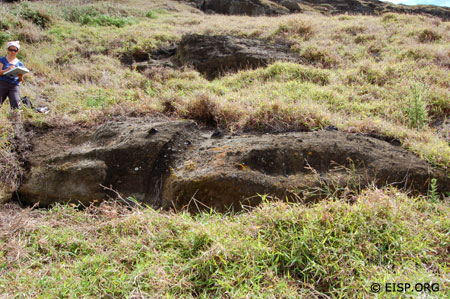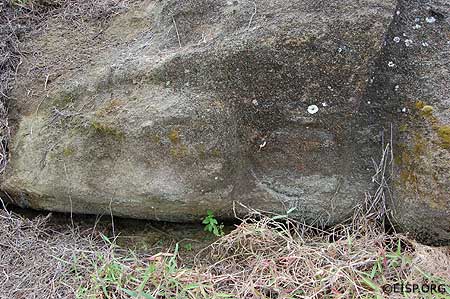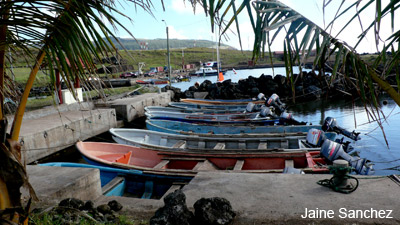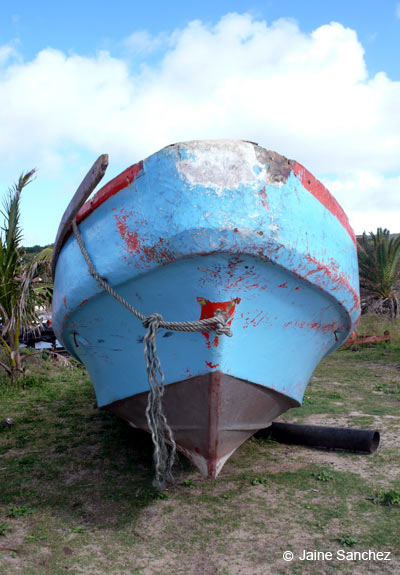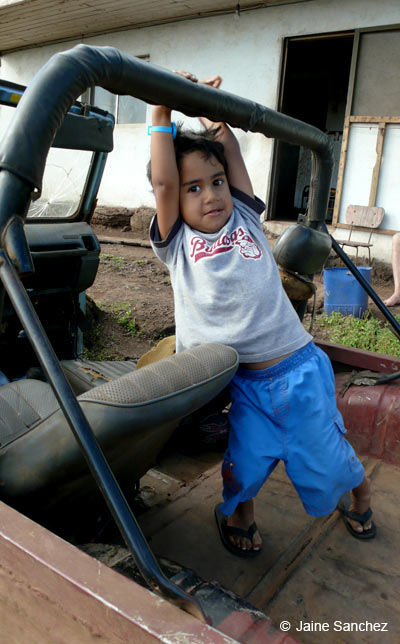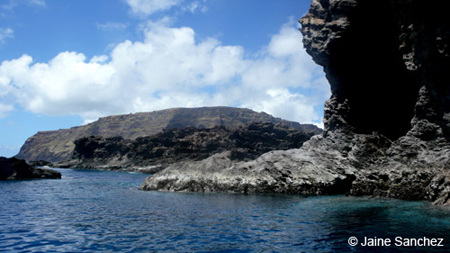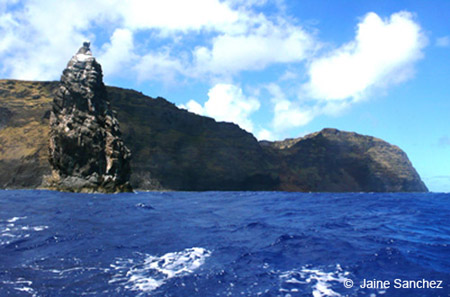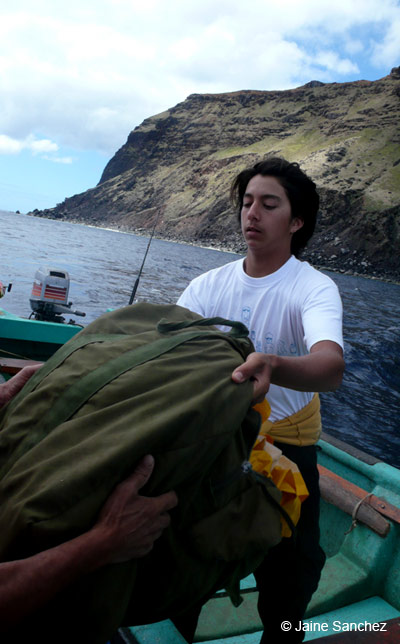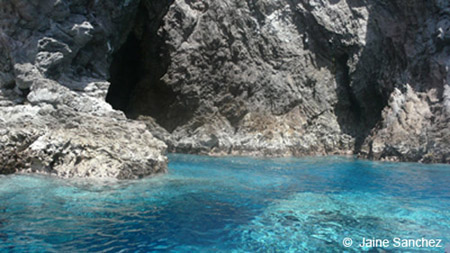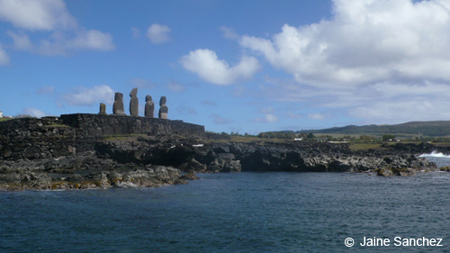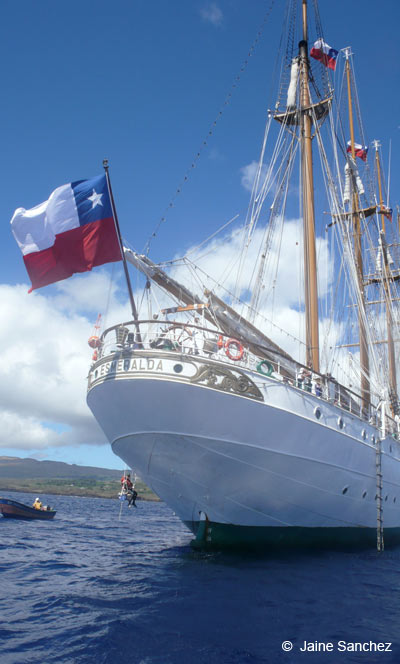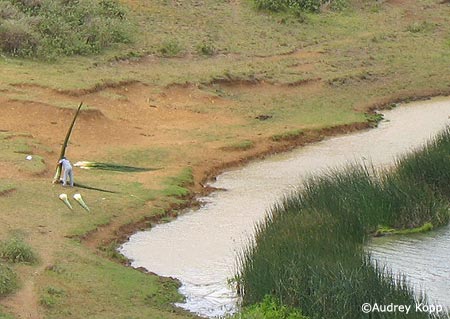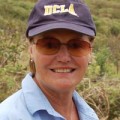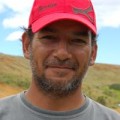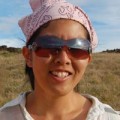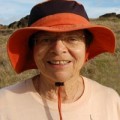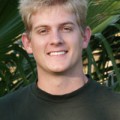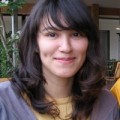Field Dispatches: November 2007
Dear EISP colleagues and site visitors,
Iaorana korua! Welcome to EISP’s dispatches, jottings, and journal entries, sent to you by our 2007 field team on Rapa Nui. Our records and reminders are of work done, people encountered, questions posed, and ideas explored. We are happy to share with you our adventures on Rapa Nui!
—Jo Anne Van Tilburg and the EISP 2007 Field Team
8 November 2007
We departed LAX at 1 p.m. November 2. Twenty-one plus hours and two stops later we landed on Rapa Nui under a brilliant blue colored sky sprinkled with fat puffy white clouds. The land which greeted us displayed brilliantly colored tropical plants: the familiar bougainvillea , fiery-flowered coral trees unlike the naked branches we now see at home, startling white lilies and a white-petaled daisy-like flower. Sunday we worked setting up the office at the site of the about-to-be-finished Mana Gallery which will serve as a showplace for the work of local artists. Then Alice took Jaine and me on a tour of downtown Hanga Roa, our new hometown. Monday morning we continued our walking tour as we visited the local cemetery, replete with flowers, both plastic and homegrown.
Then we drew closer to the ever present ocean with its compelling wave action attracting surfers, filling lava bed tide pools, and shooting spray 15 feet high. We walked to our first ahu (platform). Its five moai silently attended our progress and I hope wished us good luck in our work. Another moai, lava stone outlines of houses and garden plots were the first of many we will eventually see.
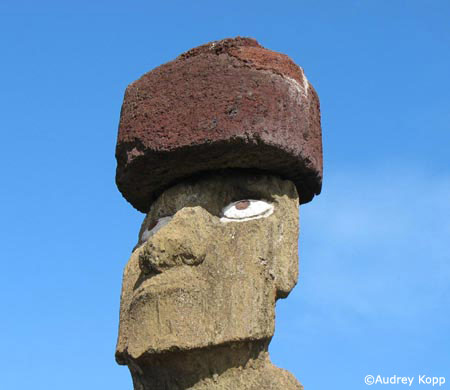
Tuesday we joined the Archaeological Tours group. First stop: Tongariki – the oft-pictured reconstructed 15 moai site. They are really tall! Only one pukao (top knot) was found to match and consequently placed in its original position. Others lie nearby. We see lava rocks everywhere, some poking up through the ground, many more lying everywhere or turned into the building blocks for fences. Large flat surfaces on the ground displayed petroglyphs depicting life size huge tuna, an over-sized turtle, and birdmen.
Then back into the vehicles to visit Rano Raraku where I finally felt transported to another world. We hiked into the interior of the crater and saw a magnificent lake edged by reeds and surrounded at a distanced by yellow walls, the tuff from which the statues were carved. How overwhelming to be at the birthplace of themoai. A quick survey of the area, out of the quarry, and lunch under a grove of trees. Then a walk around the exterior of the quarry with moai popping up everywhere, a sight beyond anything I had ever imagined. They had never made it down from the quarry site but I had been privileged to make my way up to them.
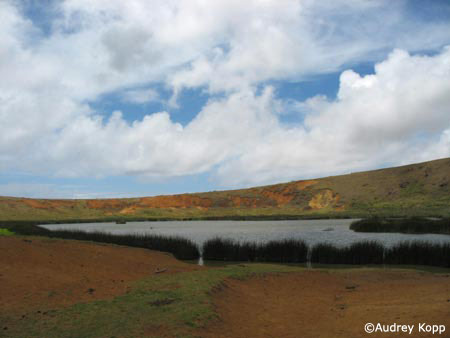
Wednesday’s trip halfway around the island to Anakena Beach brought many stops along the way as we followed the coast. I have been on coastlines on islands all over the world, but this one feels so different. We are not close to a mainland or another island. The Pacific surrounds our pinpoint of land in every direction for more space than I can conceive.
Yet we are living in a modern house, eating savory food at a nearby hotel, watching kids go to school, wandering in and out of souvenir shops, and using e-mail!
— Audrey Kopp
9 November 2007
Today we visited Orongo with the Archaeological Tours group. Located at the southwestern tip of the island, here, the representatives of the birdman cult executed the extremely dangerous task of retrieving a prized sooty tern egg from a tiny island off the coast in order to award it to one of the many chiefs competing for the year long title. As we arrived the ubiquitous fog and constant drizzle provided a deeply melancholic mood that was chilling, exciting, and very beautiful. Orongo’s restored ceremonial village with its striking architecture and plethora of bird-themed petroglyphs left a lasting impression.
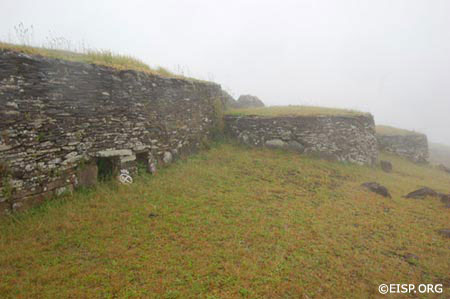
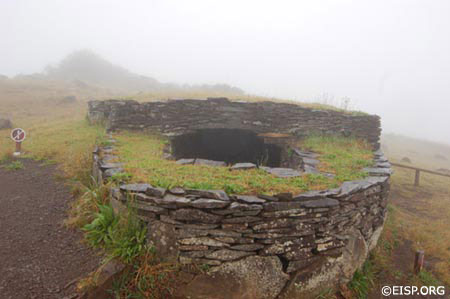
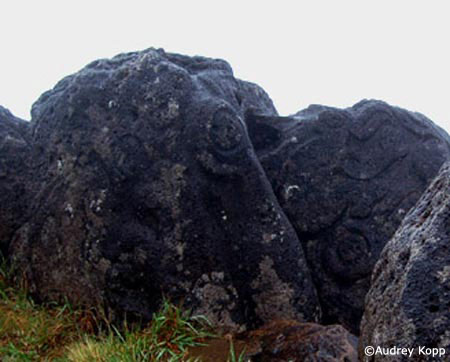
Leaving Orongo utterly soaked, we then prepared for the tour group’s farewell umu at the Hotel Otai. After a week of accompanying the group on their various sightseeing adventures it was nice to enjoy this last feast with them. The evening began with a round of Pisco Sours and a lovely performance by a local Rapa Nui dance group.
After the recital we all went to witness the umu’s uncovering. The umu, an underground oven filled with various meats and edible roots had been buried in the backyard of the hotel. The evening was a great success.
Everyone enjoyed the succulent meats and refreshing watermelon served for dessert and at end of the affair we heard heart-warming toasts dedicated to Jo Anne and Cristian. It’s the end of the first week on Easter Island and I am so overjoyed to be here working, learning, and experiencing with such a fantastic and inspirational group of people. Thank you Jo Anne, Audrey, and Alice!
—Jaine Sanchez
16 November 2007
This past week, we’ve been back at the quarry slopes field checking our map of the interior quarries and updating the records for statues mapped by the University of Chile on the exterior quarries. The lake edge inside the crater is ringed by high brush containing guava trees, thistles, a lupine locally calledchocho and other overgrown wildflowers and grasses. The area around the trail has been cleared and maintained by the park service so the tourists can view the statues while keeping on the trails. When the map is published next year, the park service will have the information needed to make crucial decisions regarding the protection and conservation of specific statues in the quarry.
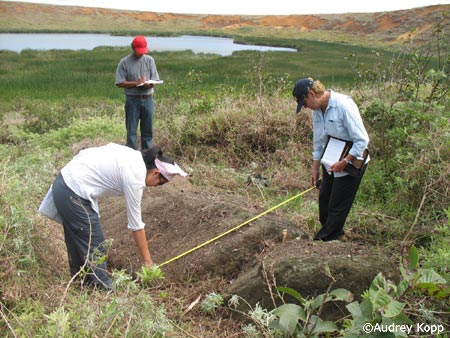
Using historical photos from the last century as a visual guide, we relocated a moai numbered 247 on the University of Chile atlas. It is very eroded and shows very little surface detailing, but the measurements are of the exact proportions of a moai. It was photographed and will be mapped into our Interior Rano Raraku map when Matthew Bates arrives to take the survey points.
On the exterior quarry, we collected more documentation about the statues, including measurements, photos, and condition reports. Nearly half of the statues on the whole island have not left the quarries, and the ones on the exterior section are in the best condition. There are better quality stone and taller statues there than inside the crater. The exterior quarries are also deeper and have more levels, the negative spaces appearing as voluminous caverns. Many statues that are fully detached and moved off their original locations remain lying on top of other moai forever attached to the bedrock.
Jaine and I cleared out the grass around Moai 127 and 128, both have been partially buried by the overburden of soil coming off the top of the slope. We find a petroglyph on the right cheek of Moai 128. It depicts the face of makemake, the god of creation, most often seen next to the birdman petroglyphs on the boulders of Orongo. The position of the face indicates it was done long after this statue was abandoned, but it is unknown to me if this is an ancient or modern carving.
This weekend, the rain showers are keeping us indoors and on the computers. We have plenty of data entry and image cataloguing to keep us busy until the rain clouds blow over.
—Alice Hom
17 November 2007
Everyday on Easter Island is a feast for the eyes. At every corner of the jubilant city center that is Hanga Roa one encounters jewel-hued houses, lush foliage and most notably, the exquisite Pacific Ocean that has the ability to alter its appearance and reveal its many glorious shades of blue. Jo Anne, Audrey, Alice, and I along with the Traveller tour group were lucky enough to enjoy a day at sea. We departed from Hanga Piko, the local dock and trailed along for about two kilometers viewing the caves of Ana Kai Tangata, the three Motu, Ahu Tahai, and finally sailed around the Esmeralda, the Chilean Navy ship. Our ocean excursion was thrilling, beautiful, and an awe-inspiring sight that gave us another incredible way to view Rapa Nui.
—Jaine Sanchez
19 November 2007
Mental Snapshots of Rapa Nui Flora and Fauna:
+teeny lizards no more than 3 inches long perching on the walls of the house where we are living
+lovely lantana and canna lily blossoms, some with familiar colors and others not, plus the ubiquitous dandelion
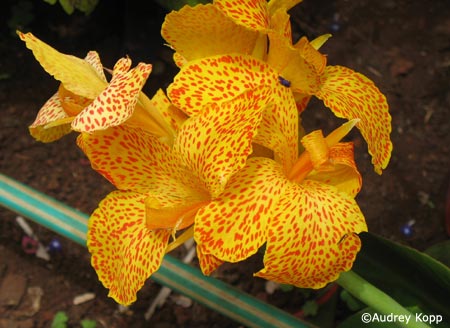
+dogs everywhere quietly roaming the streets of Hanga Roa, our town, and the only town
+two cats lying comfortably side by side on a porch
+ opaque-winged dragonflies flitting around the covered deck we often use for hanging wash
+ birds struggling to take wing while heavy winds are flying about
+yummy unfamiliar fresh fish cooked perfectly for dinner in the hotel restaurant
+banana, papaya, guarana, avocado, guava, coconut trees all offering their produce
+beets, lettuce, tomatoes, taro from the hotel garden
+hibiscus, poinsettia, eucalyptus, oleander all brought here one way or another and flourishing on the island
+roosters in nearly constant voice near the house; a mother hen and eight chicks coming by daily as they seek food from the earth in our gardens
+local people drlving white cars, pickups, taxis, riding horseback or on motor bikes and bicycles, but rarely on foot
+trying to evade purple thistles with prickles at the ready as we thrash through brush in the volcano interior seeking relics clearly depicted in early photographs and sketches
+lichen and moss growing on statues on the exposed exterior of the quarry volcano with their color heightened by the light of the cloudy, rain-laden skies above
+horses running free in the crater and sometimes coming within a few meters of us
+watching men cutting down tall reeds from the edge of the crater’s lake to be used in an island festival next year
+wee ants joining us for our picnic lunch
+an emptied honeycomb hanging from the underside of a fallen head

I hope all these scenes and more remain with me wherever I go after I leave the island.
—Audrey Kopp
25 November 2007

The past few days we have been transversing the island visiting statues and other features which have been recorded by EISP and investigators whose pictures are archived in our project. We photographed and assessed the condition of statues on the transport road and along the northern coast so that their status can be compared with previous photos and records.
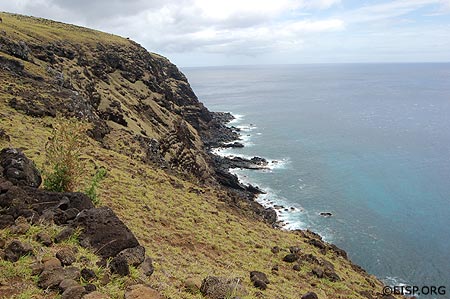
We walked up and down steep slopes, over lava rocks hidden in deep grasses, tried to hold ourselves upright in strong winds, and thoroughly enjoyed the vistas available to us as we left the usual tourist paths.
—Audrey Kopp
 English
English  Español
Español 